Graft unveils towers linked by bridges for Berlin's Holzmarkt
News: the second Berlin city centre proposal revealed today is a cluster of five towers by Graft and Kleihues + Kleihues Architekten, which will be connected on their upper levels by a chain of bridges.
Named Eckwerk, the mixed-use development will be located beside the railway viaduct in Berlin's Holzmarkt area. It will contain a series of flexible units that can be used as homes or workplaces, as well as a large public atrium conceived as a "multi-storey marketplace".
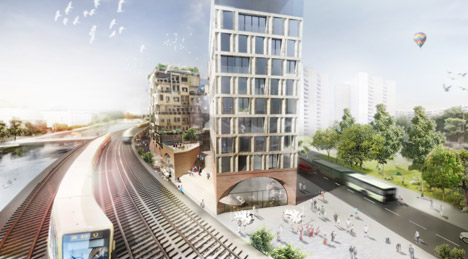
Graft – who has offices in California, Berlin and Beijing – teamed up with German firm Kleihues + Kleihues Architekten to develop a building that they claim will "find answers to the social, economic and ecological questions of our times" by integrating residential and commercial activities.
The five towers will vary in height, but will all be connected by publicly accessible bridges. Known as the "experience path", the route is designed to offer residents and visitors a place to stroll with views over the city and the nearby Spree river.
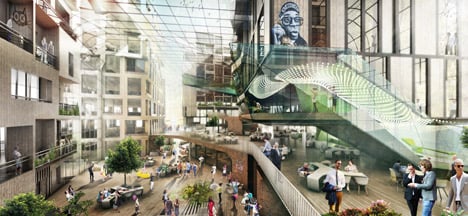
The base of the development will comprise a two-storey podium modelled on the vaulted brickwork structure of the nearby viaduct. Its surface will accommodate a multi-level terrace sheltered beneath a steel and glass canopy, which is also expected to become an informal workplace.
"The central idea is to create an inspiring and vivid place which sets new benchmarks with respect to the relationship between work and living as well as between public life and privacy," said Graft in a statement.
The exterior of each tower will be clad in wood, intended to reference the history of Holzmarkt as a lumber market.
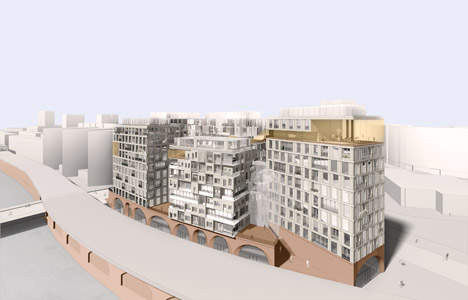
Construction of Eckwerk is set begin on site in 2015, becoming the latest in a string of major new buildings underway in the German capital. This morning J Mayer H unveiled designs for a new Berlin shopping centre, while Frank Gehry is working on a skyscraper and OMA is expanding the headquarters of multimedia firm Axel Springer.
Here's a project description from Graft and Kleihues + Kleihues Architekten:
Eckwerk Design
Under the framework of open dialog the two architecture firms Graft and Kleihues + Kleihues, as well as the Genossenschaft für urbane Kreativität (Cooperative for urban Creativity) developed an exemplary complex of buildings which seeks to find answers to the social, economic and ecological questions of our times.
The central idea is to create an inspiring and vivid place which sets new benchmarks with respect to the relationship between work and living as well as between public life and privacy. Start of construction is planned for 2015 on the northern part of the Holzmarkt- area along the Spree which was home to the legendary Bar 25 up until 2011.
The design for the so-called Eckwerk takes on the characteristics and qualities of the location. In particular, it refers to the Stadtbahnviadukt, which runs like a golden thread through the centre of the city and gives identity to the property at hand. The base of the design is a pedestal which aligns with the streets stretching out as a backdrop, follows the progression of the viaduct in a two-storey fashion and, on the northern side, expands vertically in topographic steps.
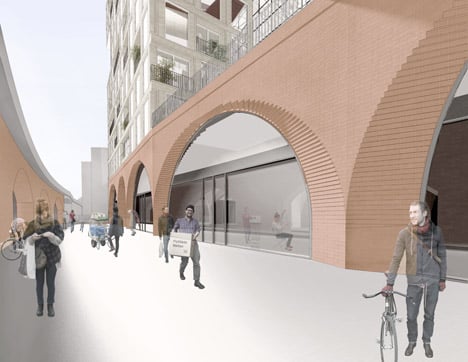
Inspired by the materiality and the form language of the viaduct, a place of interaction which goes beyond the building itself is created between the latter and the pedestal in the form of an alley from which the main entrances can be reached and from which public functions can be accessed.
The pedestal elevates the main level to the same height as the viaduct and allows, like a city balcony, a direct look onto the water. On the pedestal five independently accessible towers are arranged, each providing to a maximum degree well exposed and highly flexible surfaces which can be used either for working or living.
The terraced landscape is designed as a multi-storey marketplace and interfuses, as an expansion area for Co-Working Spaces, the floor plan of the towers. In order to allow using these throughout all seasons the area is covered by a climate shell in the form of a delicate structure composed of steel and glass.
The decision to separate the construction volume in separate towers is not only an attempt to meet the requirements of proportions but also creates the feeling of open space through manifold views and outlooks, which in turn achieves to remove the boundaries between house and city (private and public). In addition, qualitative hierarchy on the property is eliminated through the sliding scale of the towers' height towards the south. A direct visual contact to the Spree is maintained, even from the "second row".
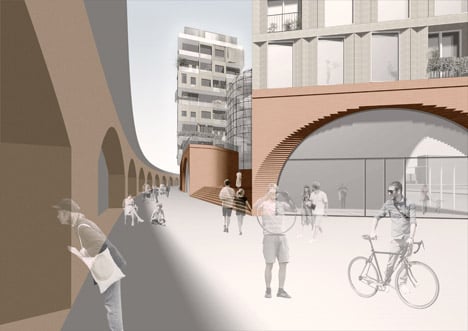
The five towers are connected through an "experience path", the so-called "mountain trail". It connects the ensemble and expands locally into spaces of topically different design which serve as areas of exchange and relaxation. In parallel, it can be used for strolling and also presents an opportunity to the public to follow the events on the pedestal and terrace level or to get a view onto the city and the Holzmarkt-village without being obstructed by the work and living spaces.
In contrast to the heavy and durable material of the pedestal, the towers embody lightness and changeability through their wooden frontage. Wood, which is regarded as a renewable future technology, also stands for tradition of Holzmarkt.
Not only floor plans but also facades are based on a modular design principle which provides the possibility for individual modification and adaptation.